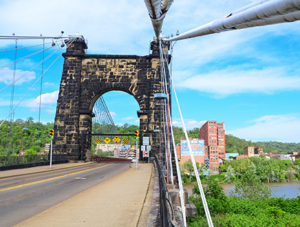By Samantha Cart

A Treasured Past
Throughout its 250-year history, the city of Wheeling has been many things, including the first capital of the Mountain State and an industrial giant for industries such as steel, iron and glasswork. While its population and economy suffered for a number of years as factories began closing their doors, a recent resurgence has brought with it an influx of new businesses, young families and advocacy efforts to honor the city’s historic landscape.
“There was a time when Wheeling residents seemed to only reflect on the city’s storied past—not what it could be in the future,” says Frank O’Brien, director of the Wheeling-Ohio County Convention & Visitors Bureau (CVB). “The sentiment seemed to change about 15 years ago when one of Wheeling’s iconic downtown buildings was brought back to life. The Stone & Thomas building was repurposed and is now home to hundreds of new upscale apartments. The investment in the Stone Center demonstrated that Wheeling was down but not out.”
This investment spurred others, and soon buildings that once housed plants and warehouses were rehabilitated into law firms, banks and small businesses, thanks to partnerships between local and federal governments, preservation agencies and developers. This turning point in Wheeling’s history changed the conversation on what is possible for the Friendly City. Soon residents were asking what was next instead of looking back at what once was. In 2016, Reinvent Wheeling, the city’s Main Street program, merged with Wheeling Heritage, adding a focus on business development, city planning and public art to an already thriving movement.
A Call to Action
In collaboration with organizations like the Regional Economic Development Partnership (RED), City of Wheeling, Wheeling-Ohio County CVB and Wheeling Area Chamber of Commerce, Wheeling
Heritage added fuel to a growing fire that had already been ignited in the heart of downtown.
Since 2015, Wheeling Heritage has generated $50 million in downtown investments; awarded more than $50,000 to projects and small businesses through its community crowd-funding program, Show of Hands; helped bring CO.STARTERS, an entrepreneur training program, to Wheeling; invested more than $8 million in the reuse of historic properties; helped reopen Wheeling’s Capitol Theatre; supported 1,109 jobs; and generated $86.6 million in economic impact and $6.4 million in tax revenue.
In that same time frame, Wheeling’s downtown vacancy rate has decreased from 32 percent to 15 percent, 124 buildings have seen improvements, and the downtown has netted 37 new businesses. The growth of shopping, dining and art amenities and the addition of 100 new multi-family apartments have led to more people living in downtown Wheeling than
at any other time in its history.
“We have weathered the economic storm from the reduction of the coal and steel economies over prior decades, and now we are in the early stages of a renaissance,” says Wheeling Mayor Glenn Elliott. “New businesses are popping up, and Wheeling natives who moved away in years past are coming back. We are being seen as a city with brighter days ahead, and for the first time in decades, a sense of optimism is taking root within the community.”
These incredible initiatives led to Wheeling being recognized as one of the best and brightest Main Street communities in the country in 2019. Every year, the National Main Street Center recognizes standout communities that have implemented comprehensive, preservation-based commercial district revitalization plans with the Great American Main Street Award (GAMSA).
These communities exemplify the use of the Main Street approach by revitalizing traditional downtowns and neighborhood business districts into thriving destinations with strong small business communities. In March at the Main Street Now Conference in Seattle, WA, Wheeling was named one of three GAMSA winners alongside Alberta Main Street in Portland, OR, and Wausau River District in Wausau, WI.
“Receiving this award means that real, substantive changes are being seen in our downtown,” says Jake Dougherty, executive director of Wheeling Heritage. “I hope this award will give another morale boost to the community, I hope it will encourage some who have counted Wheeling out to rediscover what it has to offer, and I hope it encourages others who have never been here to discover it for the first time.”
A Bright Future
The changes that have occurred over the past several years as well as the GAMSA have inspired more and more people to take a chance on their dreams in Wheeling, whether those dreams include opening a new business or starting fresh in a new community.
“Wheeling is the best small town in America,” says Erikka Storch, president of the Wheeling Area Chamber of Commerce. “We are a very philanthropic, supportive community. If you believe in your idea and are willing to take a chance, this community will embrace you and help you thrive.”
Don Rigby, executive director of RED, believes Wheeling’s recent success and its openness to new people and ideas are the result of the common goals and close connections shared by city leadership
“The sharing of ideas among successful leaders is a terrific opportunity,” he says. “Our business community is vibrant and welcomes new companies, and the businesses and industries we have are our best selling points.”
As the birthplace of West Virginia, an early industrial hub and a designated National Heritage Area, Wheeling is rich in history. While that history is honored and revered by residents, people are now looking toward the city’s bright future.
“Today, you still hear your fair share of stories of the downtown of yesteryear, but more often than not, you are hearing conversations celebrating the present and looking to the future,” says Elliott. “It is tremendously exciting to be a part of those conversations. I love Wheeling’s history as much as anyone, but I never want our city to be thought of as a place that used to be something better. I believe—as do a growing number of local residents—that Wheeling’s best days lie ahead.”








